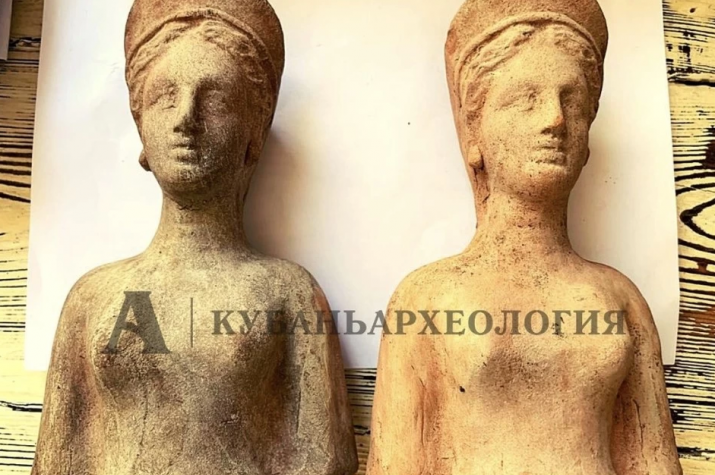In Anapa, during the excavation of a pottery quarter of the ancient city of Gorgippia, figurines of the goddess Persephone were found. The finds are 2 thousand years old. They were discovered by the representatives of the Russian archaeological expedition. The figurines are planned to be included in the tourist route of the Russian Geographical Society "The Golden Ring of the Bosporan Kingdom" as objects of display.
"As part of the expedition of ‘Kubanarheologia’, the experts from Krasnodar and St. Petersburg discovered two terracotta figurines during excavations on the territory of one of the sanatoriums in Anapa. In the 4th-2nd centuries BC, a pottery quarter of the ancient city of Gorgippia was located here. Two not damaged by time statuettes of Persephone, the goddess of fertility and mistress of the underworld from ancient Greek mythology, were found at a depth of about 2.5 m under the collapsed dome of a pottery furnace. Until now, only one such terracotta figurine was known in Russia, originating from a burial and broken into several pieces," noted the Head of the Department of the Ancient Culture History at the Institute of History of Material Culture of the Russian Academy of Sciences, Vladimir Goroncharovsky.
Director General of "Kubanarheologia", Natalia Zheliba, added that another interesting find was made nearby - a relief, in the center of which is depicted the goddess Cybele sitting on a throne with a lion cub on her knees.
"On both sides of her are the figures of the messenger of the gods, Hermes, and Hecate, the patroness of magic and witchcraft. This is the best limestone relief with this type of theme of all known in the territory of the Bosporan Kingdom," Zheliba said at the end of the field season.
In the designated area, the archaeologists also found numerous evidence of the Russian-Turkish wars of the 18th – 19th centuries and the Crimean War, which lasted from 1853 to 1856.
"At the end of the 18th century, the Ottomans turned Anapa into a first-class fortress, surrounded by a moat up to 8 m deep. Its garrison numbered 25 thousand people, 83 cannons and 19 mortars were located on seven bastions and walls. The fortress had an inn, two mosques, baths, barracks for janissaries, a bazaar and more than 500 stores and coffee shops. Therefore, it is not surprising that the most numerous finds in the Turkish layer were earthenware coffee cups and clay pipes," a scientist said.
According to him, during excavations, cannonballs of different sizes were often found.
"Since 1788, Russian troops besieged Anapa six times and took it by storm four times. The Russian-Turkish confrontation ended here only in 1829, when, according to the Treaty of Adrianople, the fortress finally passed to Russia. The last time it took part in hostilities during the Crimean War, having survived the 24-hour bombardment of the British squadrons on August 7, 1854," Goroncharovsky said.
He also added that in the near future it is planned to organize an exhibition in the sanatorium, which will present photographs from various stages of excavations and copies of the rarest exhibits.
“The Golden Ring of the Bosporan Kingdom” is a project of the four southern regions of Russia in the field of tourism, initiated by the Krasnodar Regional Branch of the Russian Geographical Society and the Ministry of Resorts, Tourism and Olympic Heritage of the Krasnodar Territory. The project includes more than 35 objects of cultural and historical heritage, museum complexes, archaeological sites and modern venues displaying antiques for the tourists on the territory of 12 cities in southern Russia. The overall coordination of the project is carried out by the Russian Geographical Society with the support of the Federal Agency for Tourism. You can learn more about the project, choose places to visit and draw up a travel route on the website.

